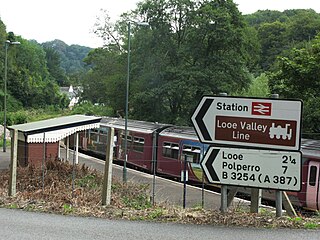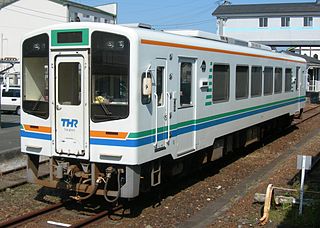Related Research Articles

The Looe Valley Line is an 8+3⁄4 miles (14 km) community railway from Liskeard to Looe in Cornwall, United Kingdom, that follows the valley of the East Looe River for much of its course. It is operated by Great Western Railway.

Liskeard railway station serves the town of Liskeard in Cornwall, England. The station is approximately 18 miles (29 km) west of Plymouth on the Cornish Main Line and 265 miles (426 km) from London Paddington via Bristol Temple Meads. It is the junction for the Looe Valley Line.

Looe railway station serves the twin towns of East and West Looe, in Cornwall, England. The station is the terminus of the scenic Looe Valley Line 8.75 miles (14 km) south of Liskeard.

Seaton is a village on the south coast of Cornwall, England, at the mouth of the River Seaton 3.8 miles (6.1 km) east of Looe and ten miles (16 km) west of Plymouth. The village is in the civil parish of Deviock.

Sandplace railway station is an intermediate station on the scenic Looe Valley Line in Cornwall, England, United Kingdom. The station serves the hamlet of Sandplace and is 6.5 miles (10 km) south of Liskeard.

Coombe Junction Halt railway station serves the villages of Coombe and Lamellion near Liskeard, Cornwall, England, UK. It is situated on the Looe Valley Line and operated by Great Western Railway. All trains on this line have to reverse at Coombe Junction, but very few continue the short distance into the platform to allow passengers to alight or join the train.

Hessenford is a small village in south-east Cornwall, United Kingdom, four miles west of St Germans on the A387 Polbathic to Polperro road. The village had a population of 170 at the 2001 census. It is in the civil parish of Deviock. The river Seaton runs through the village and a mill was recorded here in 1286; the last mill closing in the mid-20th century.
Looe is a town in Cornwall, England, UK.

The Sōya Main Line is a Japanese railway line operated by Hokkaido Railway Company in Hokkaido. The line connects Asahikawa Station in Asahikawa and Wakkanai Station in Wakkanai, and is the northernmost railway line in Japan. The name comes from Sōya Subprefecture.
The Liskeard and Looe Railway was a railway originally built between Moorswater, in the valley west of Liskeard, and Looe, in Cornwall, England, UK, and later extended to Liskeard station on the Cornish Main Line railway. The first section was opened in 1860 and was owned by the Liskeard and Looe Union Canal Company, whose canal had earlier been built to convey sea sand and lime up the valley of the East Looe River, for the purpose of improving agricultural land.

The Tenryū Hamanako Line, or Tenhama Line for short, is a Japanese railway line in Shizuoka Prefecture, paralleling the north coast of Lake Hamana between Kakegawa Station in Kakegawa and Shinjohara Station in Kosai. This is the only railway line of Tenryū Hamanako Railroad.

Moorswater railway station was the centre of operations for the Liskeard and Caradon Railway and the Liskeard and Looe Railway. The two railways made an end on junction here. It was the site of the lines' engine shed, also a china clay works which is now used as a cement terminal.

Wotton railway station was a small station in Buckinghamshire, England, built by the Duke of Buckingham in 1871. Part of a private horse-drawn tramway designed to carry freight from and around his lands in Buckinghamshire, Wotton station was intended to serve the Duke's home at Wotton House and the nearby village of Wotton Underwood. In 1872 the line was extended to the nearby village of Brill, converted to passenger use, equipped with steam locomotives, and renamed the Brill Tramway. In the 1880s, it was proposed to extend the line to Oxford, but the operation of the line was instead taken over by London's Metropolitan Railway.

Millendreath is a hamlet in the parish of Looe, Cornwall, England, situated two miles east of the town of Looe.

Lawes is a rural locality in the Lockyer Valley Region, Queensland, Australia. In the 2016 census Lawes had a population of 328 people.

Feluga is a rural locality in the Cassowary Coast Region, Queensland, Australia. In the 2016 census Feluga had a population of 251 people.
The St Germans & Looe Railway was a proposed new railway in Cornwall by the Great Western Railway, providing a direct connection between St Germans and Looe. The railway was proposed in 1935 and authorised in 1936, and work commenced in 1937. By the time that war began in 1939 only a small amount of work had been completed, and it was abandoned. Had the railway been completed, it would have involved the construction of four stations, three tunnels and two viaducts.
Hessenford railway station was a proposed railway station in Hessenford, Cornwall which would have formed one of four stations on the St Germans & Looe Railway. The railway was proposed in 1935 and authorised by the Great Western Railway Act 1936, and work commenced in 1937. By the time that war began in 1939 only a small amount of work had been completed, and it was abandoned. Hessenford station itself was unbuilt.
Seaton railway station was a proposed railway station in Seaton, Cornwall which would have formed one of four stations on the St Germans & Looe Railway. The railway was proposed in 1935 and authorised by the Great Western Railway Act 1936, and work commenced in 1937. By the time that war began in 1939 only a small amount of work had been completed, and it was abandoned. Seaton station itself was unbuilt.
Looe high-level railway station was a proposed railway station in Looe, Cornwall which would have formed one of four stations on the St Germans & Looe Railway. Looe was to be the terminus station; it was to be set at a higher-level than the existing Looe railway station on the Liskeard and Looe Railway. The railway was proposed in 1935 and authorised by the Great Western Railway Act 1936, and work commenced in 1937. By the time that war began in 1939 only a small amount of work had been completed, and it was abandoned. Looe station itself was unbuilt.
References
- ↑ "ELECTRIC RAIL SPEED UP". Tweed Daily . XXIII (310). New South Wales, Australia. 29 December 1936. p. 8. Retrieved 9 July 2021– via National Library of Australia.
- ↑ "Chronological Tables – Local Acts: Part 168 (1935-1936)" . Retrieved 10 July 2021.
- ↑ "Bruce Hunt: Proposed line to Looe" . Retrieved 10 July 2021.